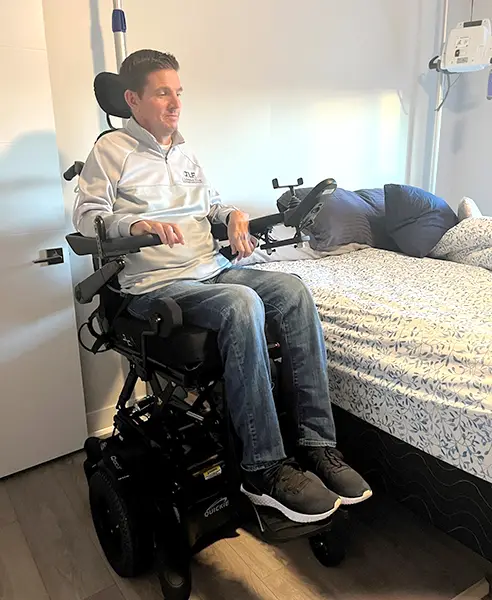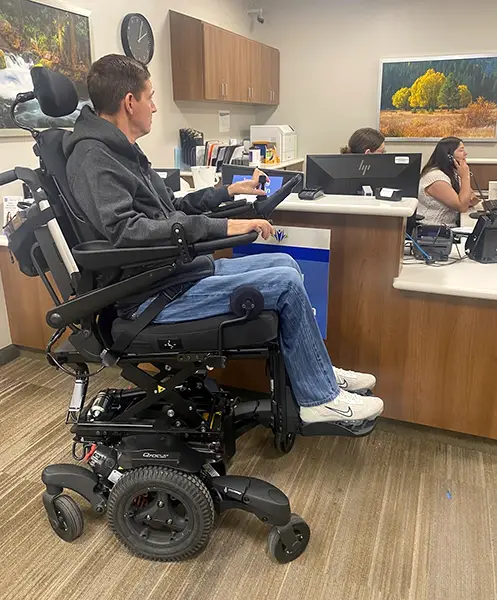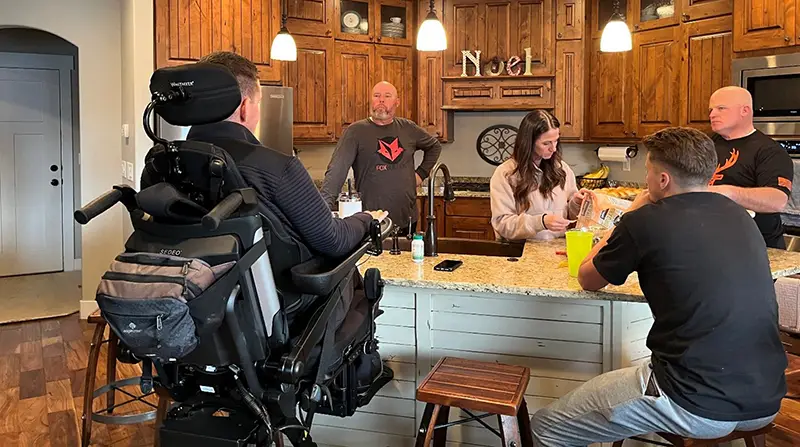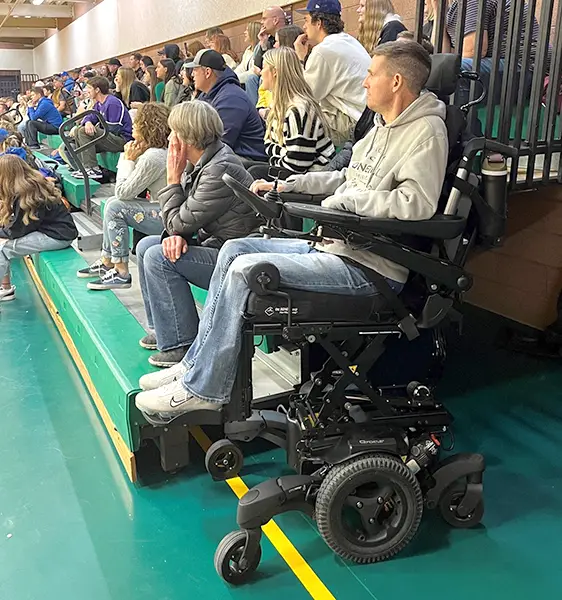Lonnie is a father of four sons, living just south of Salt Lake City, Utah. He owns his own drafting and design company in the construction industry. Over 20 years ago, Lonnie was in a motorcycle accident resulting in a spinal cord injury and has a C4 tetraplegia diagnosis. Lonnie now uses a QUICKIE Q700 M power wheelchair and can independently lift his hand onto the joystick to access the controls.
Lonnie has witnessed many advances in assistive technology since his injury. One exceptional development has been power seat elevation, which has made transferring safer. With power seat elevation, Lonnie can bring his wheelchair's seat to the same height as his bed or another platform he might be transferring to. This enables the person assisting with the transfer to execute a lateral slide transfer without having to lift Lonnie's weight upward.
 Lonnie demonstrating rising to mee the height of the bed.
Lonnie demonstrating rising to mee the height of the bed.
Accessing counters at hotels, doctors' offices, movie theaters, and other businesses can be frustrating when sitting at standard wheelchair level. Sometimes the person across the counter does not even know when a wheelchair rider is present. Conversation and interactions are also difficult and may feel awkward at best. Having the ability to raise the seat so that he can be seen is a benefit that Lonnie can now take advantage of when approaching high counters. He can also access high counters in private homes, when going out to bars, and in other places where high counters are present.
 Lonnie is able to be seen and speak with people over the high counter in this office.
Lonnie is able to be seen and speak with people over the high counter in this office.
 Lonnie uses seat elevation when visiting with friends over the tall kitchen island.
Lonnie uses seat elevation when visiting with friends over the tall kitchen island.
Lonnie's drafting and design company has been successful in many industrial and residential areas throughout Utah. Being able to move with an elevated seat alongside his clients provides Lonnie the opportunity for face-to-face communication. Instead of hyperextending his neck or straining to look up at the people who are touring a site or viewing a home, Lonnie can bring himself to a level where he is shoulder-to-shoulder with the people he is working with. This assists in preventing neck pain from overuse of the extensor muscles.
Lonnie's four sons are involved in various sports. When he attends their games, he is now able to see the court or field better simply by making use of his wheelchair's power seat elevate function.
 Lonnie attending one of his sons' games.
Lonnie attending one of his sons' games.
Another important safety factor and benefit of seat elevation comes into play when pushing through a crowd. When riders can raise themselves up to typical standing height, they are much more visible in a crowd. This visibility reduces the potential for someone bumping into or tripping over the wheelchair and possibly injuring themselves or the rider.
In summary, power seat elevation for individuals with high-level cervical spinal cord injury is beneficial for performing safe transfers, accessing high counters, conversing face-to-face with people who are standing, and maneuvering in a crowd. The Centers for Medicare and Medicaid (CMS) recognize these benefits as a medical necessity, allowing for seat elevation to be paid for. Learn more about QUICKIE's power seat elevation, C-Me. Learn more about CMS's expanded funding options.
With over 40 years of clinical practice as an OT, Jessica Presperin has worked in all sectors of the wheelchair and seating industry as a master clinician, supplier, manufacturing consultant, design representative, and educator. Dr. Presperin was a pioneer in the development of the profession of wheelchairs and seating in the 1980s and has spent the last two decades contributing to the research world to demonstrate evidence for knowledge translation in the clinic, advocacy, and product development. She is a RESNA and AOTA Fellow, serves on the Clinician Task Force, the Seating and Wheeled Mobility Committee for AOTA, and has shared her experiences internationally through publications and presentations.